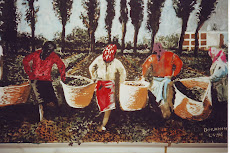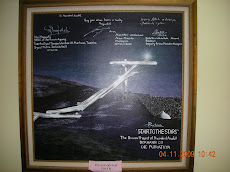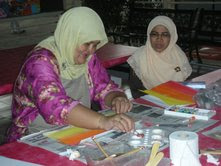Sunday, October 19, 2008
Big bucks with Asean works
Art & about: Big bucks with Asean works
LUCIEN de GUISE
Older works from Southeast Asia also did well: RM4 million for Walter Spies
I Nyoman Masriadi broke more records at Sotheby’s
FALLING markets will not sound like news to anyone. The surprise feature of recent auctions is how Southeast Asia has stepped in as the saviour of Asian contemporary art.
The southeastern corner of the continent is usually seen by the big boys of Asia as inconsequential, a country cousin with some nice forests and beaches but no billion-plus population. China and India are where the money is, and until recently they were where everyone looked for the latest record-breaking art prices.
This time round it was Indonesian and other regional painters who got the applause in Hong Kong when the latest Sotheby’s auction produced a new world record for Southeast Asia.
Artists from China, on the other hand, are experiencing what auctioneers like to call “a levelling off”.
India’s hottest youngish artist, Subodh Gupta, has also seen his prices frozen.
In the case of China, it was long overdue. Enthusiasts of Chinese contemporary art are almost Maoist in their commitment. They will berate nay-sayers for failing to honour the natural supremacy of these artists.
Their biggest gripe has been how Western paintings can be worth 10 times as much as a made-in-China product. The tide of history is on their side they will say. And they can put on a better Olympics than anyone else.
Even when the good times were rolling with Chinese art, up to a few weeks ago, the prices were well short of Western artists but at least headlines were being generated. Every auction saw old records being toppled and there was less moaning about the unfairness of it all then.
Rising prices are not what collectors always like to see, unless they are planning to sell their babies. It’s speculators who like to see the sales graphs going up, and these lines have been almost vertical in recent years.
Chinese art could prove to be the biggest bubble of all, although there are at least some indigenous collectors.
At one time it was Western expats who created the market. Most Chinese buyers looked on in disbelief at what the crazy gweilos were wasting their money on.
A good old bird-and-flower painting was what the average connoisseur would like to grace his home with, and sure enough traditional Chinese art has been less badly damaged than the avant-garde. Imperial seals did exceptionally well at Sotheby’s, and there are few collectibles that shout “buy me, hedge-fund manager” as softly as these. Real collectors must have been present as that category ended up being 100 per cent sold.
The type of buyer is a crucial factor. For contemporary Chinese art, two of the top three paintings went to collectors from Europe.
For Southeast Asian art, every one of the top 10 buyers was from Asia. Sotheby’s decision to move its Southeast Asian sales away from Singapore and hold them in Hong Kong appears to be working. It is not only Southeast Asians who are buying. There are collectors from China who would like a break from the high prices, endless social commentary and Mao memorabilia that makes up art from the People’s Republic.
Southeast Asia seems be sitting on a goldmine. The regional artist pulling it all together is I Nyoman Masriadi.
Being Balinese seems to give him an edge over most of his Indonesian peers, and something much larger than an edge over artists from China. He tackles social issues with wit and a cartoon-like immediacy.
When I wrote about him a year ago, it didn’t look like his prices could continue to rise at anything like the rate they had done, which was many hundred per cent over a few years. A year later, the record has gone from RM900,000 to over RM3 million.
His painting technique is unique – for the moment – although other Indonesian artists are already knocking off the shiny three-dimensional look that Masriadi pioneered.
Another attraction is pithy titles in Bahasa Indonesia. So basic I can understand some of them. A recent record breaker featured Superman and Batman as they never appeared in DC Comics, with the title Sorry Hero, Saya Lupa.
After enlivening Sotheby’s Asian contemporary sale by setting a record with this work on Oct 4, two days later Masriadi beat his record and took three of the top 10 places at Modern and Contemporary Southeast Asian Art.
Almost every lot was sold at this one. Malaysian artists such as Ibrahim Hussein and Ahmad Zakii Anwar were represented at the Southeast Asian sale, although not the pan-Asian. Their works fetched were about one twentieth of Masriadi’s show-stopping view of a boxing match.
Indonesia is not only way ahead of the Asean pack in terms of prices. It also seems to be taking regional art to a wider audience.
Jakarta-based Larasati Auctioneers is probably the first Asian auction house of any sort to organise a sale in Europe. This happened in June. Given the state of world markets, they might not be doing this again for a while.
• Lucien de Guise is curator of the Islamic Arts Museum Malaysia. You may write to him at luciendeguise@yahoo.com
Posted by TheBorhann at 12:59 AM 0 comments
Labels: Big bucks with Asean works
Thursday, October 15, 2009
Subscribe to:
Post Comments (Atom)
































.jpg)




No comments:
Post a Comment